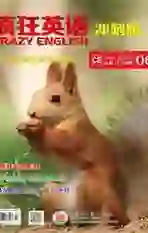Squirrels can be left? or right?handed 关于左右撇子松鼠的真相
2020-07-04高呈宝
高呈宝

埃克塞特大学的一项研究发现,那些极度偏爱使用某边爪子的松鼠,不管是右还是左——在学习时都表现不佳。
A study at the University of Exeter in January 2020 found that squirrels that strongly favored a paw (爪子) —whether right or left—performed less well at learning tasks.
Firstly, how did the researchers discover that squirrels favored a side (known as lateralization) in the first place? Moreover, once they knew which paw the squirrel preferred, how did they know the information was an intelligence or performance indicator? Finally, what does it all mean? Can researchers really draw substantive conclusions between lateralization and learning in squirrels and humans? Lets see.
Like humans, other animals often favor one side of their body for certain tasks. For example, if you ask your dog to shake hands, he may always offer his left (or right) hand. The frequency of his offer varies according to the degree of lateralization in the animal.
Dr. Lisa Leaver is the program director of the Master Science Exeter Animal Behavior program. She says some studies suggest that lateralization makes brains more efficient because each brain hemisphere is focusing on particular tasks. She explained that in fish and birds there was evidence that being strongly lateralized meant for better brain function, but that “limited data from studies of mammals suggest a weak or even negative relationship”. Leaver and her colleagues were looking for whether there was association between strong lateralization and poor cognitive (認知的) performance, and they used the gray squirrels at Exeters Streatham Campus as their subjects.
In the study, the squirrels had to take peanuts out of a transparent tube. Generally, squirrels catch food with their mouths but there was a problem: the tube was too narrow for the squirrels mouths. They had to use a paw. Researchers watched more than 30 squirrels, collecting enough data from 12 of the subjects for their report. They wanted to see how quickly each squirrel figured out the problem (assessing learning) and whether they favored one paw over the other (determining lateralization).
Their conclusion is that strongly lateralized squirrels are not good at learning. Interestingly, some research also suggests that ambidextrous (双手通用的) people (those who favor neither right nor left hand) may be more creative.
[阅读检测]
1. What can we know about lateralization in the text?
A. It makes brains less efficient.
B. It tells the difference between humans and animals.
C. It shows stronger evidence in birds than that in fish.
D. It explains the phenomenon that animals favor a side.
2. What can we infer from the study of Leaver and her colleagues?
A. The squirrels at campus are used in the experiment.
B. Strongly lateralized squirrels have better performance.
C. Enough data collected from 30 squirrels makes for the conclusion.
D. The squirrels lateralization has a poor link with its cognitive performance.
[语言学习]
难句分析
She explained that in fish and birds there was evidence that being strongly lateralized meant for better brain function, but that “limited data from studies of mammals suggest a weak or even negative relationship”.
【翻译】
【点石成金】本句同时含宾语从句与同位语从句。第一个与第三个that引导宾语从句,作动词explain的宾语;第二个that引导同位语从句,解释说明evidence的内容。
